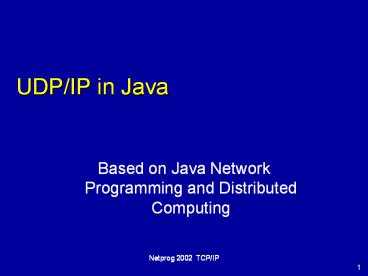UDP/IP in Java PowerPoint PPT Presentation
Title: UDP/IP in Java
1
UDP/IP in Java
- Based on Java Network Programming and Distributed
Computing
2
UDP Advantages
- Less overhead (no connection establishment)
- More efficient (no guaranteed delivery)
- Real-time applications (no error checking or
flow-control) - E.g., weather, time, video, audio, games
- Data reception from more than one machine
3
Internet Addresses
- java.net.InetAddress class
- You get an address by using static methods
- ad InetAddress.getByName(hostname)
- myAddress InetAddress.getLocalHost()
4
Printing Internet Addresses
- You get information from an InetAddress by using
methods - ad.getHostName()
- ad.getHostAddress()
- Example.
5
UDP Sockets Programming
- Sending/Receiving data.
- java.net.DatagramPacket class
- Creating UDP sockets.
- Client
- Server
- java.net.DatagramSocket class
6
Creating a UDP packet
- // to receive data from a remote machine
- DatagramPacket packet
- new DatagramPacket(new byte256, 256)
- // to send data to a remote machine
- DatagramPacket packet
- new DatagramPacket( new byte128, 128,
- address, port )
7
Creating UDP sockets
- A UDP socket can be used both for reading and
writing packets. - Write operations are asynchronous however, read
operations are blocking. - Since there is no guaranteed delivery, a
single-threaded application could stall.
8
Creating UDP Sockets
- // A client datagram socket
- DatagramSocket clientSocket
- new DatagramSocket()
- // A server datagram socket
- DatagramSocket serverSocket
- new DatagramSocket(port)
9
Listening for UDP Packets
- // create datagram packet
- . . .
- // create datagram server socket
- . . .
- boolean finished false
- while ( ! finished )
- serverSocket.receive (packet)
- // process the packet
- serverSocket.close()
10
Processing UDP Packets
- ByteArrayInputStream bin
- new ByteArrayInputStream(
- packet.getData() )
- DataInputStream din
- new DataInputStream(bin)
- // read the contents of the packet
11
Sending UDP Packets
- // create datagram packet
- . . .
- // create datagram client socket
- . . .
- boolean finished false
- while ( ! finished )
- // write data to packet buffer
- clientSocket.send (packet)
- // see if there is more to send
12
Sending UDP packets
- When you receive a packet, the ip and port number
of the sender are set in the DatagramPacket. - You can use the same packet to reply, by
overwriting the data, using the method - packet.setData(newbuffer)
13
Non-blocking I/O receiving UDP packets
- You can set a time-out in milliseconds to
determine how long a read operation blocks,
before throwing an exception. - socket.setSoTimeout(duration)
- If the duration given in milliseconds is
exceeded, an exception is thrown - java.io.InterruptedException
14
Typical UDP client code
- Create UDP socket to contact server (with a given
hostname and service port number) - Create UDP packet.
- Call send(packet), sending request to the server.
- Possibly call receive(packet) (if we need a
reply).
15
Typical UDP Server code
- Create UDP socket listening to a well known port
number. - Create UDP packet buffer
- Call receive(packet) to get a request, noting the
address of the client. - Process request and send reply back with
send(packet).
16
Debugging
- Debugging UDP can be difficult.
- Write routines to print out addresses.
- Use a debugger.
- Include code that can handle unexpected
situations.
17
Asynchronous Errors
- What happens if a client sends data to a server
that is not running? - ICMP port unreachable error is generated by
receiving host and send to sending host. - The ICMP error may reach the sending host after
send() has already returned! - The next call dealing with the socket could
return the error.

